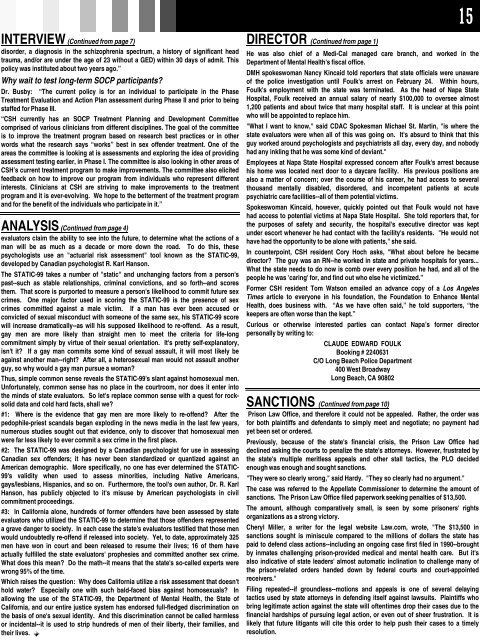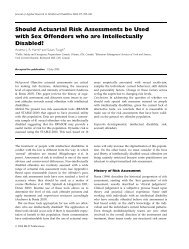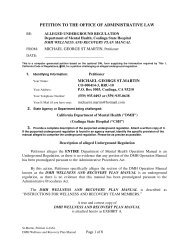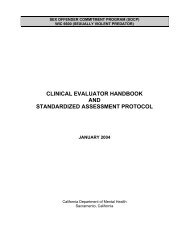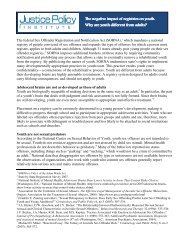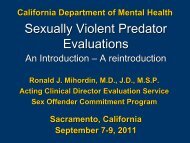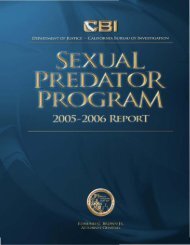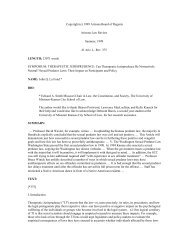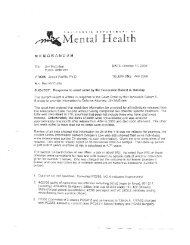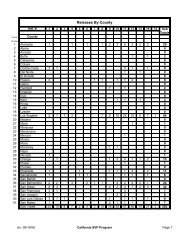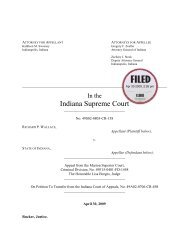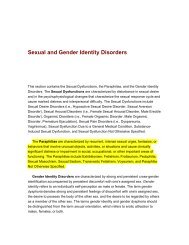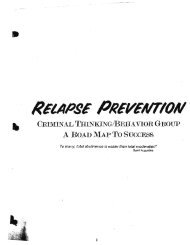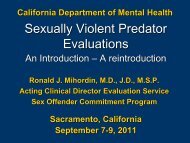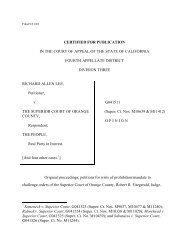UNCENSORED version of the March 2010 edition ... - Defense for SVP
UNCENSORED version of the March 2010 edition ... - Defense for SVP
UNCENSORED version of the March 2010 edition ... - Defense for SVP
Create successful ePaper yourself
Turn your PDF publications into a flip-book with our unique Google optimized e-Paper software.
15<br />
INTERVIEW (Continued from page 7)<br />
disorder, a diagnosis in <strong>the</strong> schizophrenia spectrum, a history <strong>of</strong> significant head<br />
trauma, and/or are under <strong>the</strong> age <strong>of</strong> 23 without a GED) within 30 days <strong>of</strong> admit. This<br />
policy was instituted about two years ago.”<br />
Why wait to test long-term SOCP participants<br />
Dr. Busby: “The current policy is <strong>for</strong> an individual to participate in <strong>the</strong> Phase<br />
Treatment Evaluation and Action Plan assessment during Phase II and prior to being<br />
staffed <strong>for</strong> Phase III.<br />
“CSH currently has an SOCP Treatment Planning and Development Committee<br />
comprised <strong>of</strong> various clinicians from different disciplines. The goal <strong>of</strong> <strong>the</strong> committee<br />
is to improve <strong>the</strong> treatment program based on research best practices or in o<strong>the</strong>r<br />
words what <strong>the</strong> research says “works” best in sex <strong>of</strong>fender treatment. One <strong>of</strong> <strong>the</strong><br />
areas <strong>the</strong> committee is looking at is assessments and exploring <strong>the</strong> idea <strong>of</strong> providing<br />
assessment testing earlier, in Phase I. The committee is also looking in o<strong>the</strong>r areas <strong>of</strong><br />
CSH’s current treatment program to make improvements. The committee also elicited<br />
feedback on how to improve our program from individuals who represent different<br />
interests. Clinicians at CSH are striving to make improvements to <strong>the</strong> treatment<br />
program and it is ever-evolving. We hope to <strong>the</strong> betterment <strong>of</strong> <strong>the</strong> treatment program<br />
and <strong>for</strong> <strong>the</strong> benefit <strong>of</strong> <strong>the</strong> individuals who participate in it.”<br />
ANALYSIS (Continued from page 4)<br />
evaluators claim <strong>the</strong> ability to see into <strong>the</strong> future, to determine what <strong>the</strong> actions <strong>of</strong> a<br />
man will be as much as a decade or more down <strong>the</strong> road. To do this, <strong>the</strong>se<br />
psychologists use an "actuarial risk assessment" tool known as <strong>the</strong> STATIC-99,<br />
developed by Canadian psychologist R. Karl Hanson.<br />
The STATIC-99 takes a number <strong>of</strong> "static" and unchanging factors from a person's<br />
past--such as stable relationships, criminal convictions, and so <strong>for</strong>th--and scores<br />
<strong>the</strong>m. That score is purported to measure a person's likelihood to commit future sex<br />
crimes. One major factor used in scoring <strong>the</strong> STATIC-99 is <strong>the</strong> presence <strong>of</strong> sex<br />
crimes committed against a male victim. If a man has ever been accused or<br />
convicted <strong>of</strong> sexual misconduct with someone <strong>of</strong> <strong>the</strong> same sex, his STATIC-99 score<br />
will increase dramatically--as will his supposed likelihood to re-<strong>of</strong>fend. As a result,<br />
gay men are more likely than straight men to meet <strong>the</strong> criteria <strong>for</strong> life-long<br />
commitment simply by virtue <strong>of</strong> <strong>the</strong>ir sexual orientation. It's pretty self-explanatory,<br />
isn't it If a gay man commits some kind <strong>of</strong> sexual assault, it will most likely be<br />
against ano<strong>the</strong>r man--right After all, a heterosexual man would not assault ano<strong>the</strong>r<br />
guy, so why would a gay man pursue a woman<br />
Thus, simple common sense reveals <strong>the</strong> STATIC-99's slant against homosexual men.<br />
Un<strong>for</strong>tunately, common sense has no place in <strong>the</strong> courtroom, nor does it enter into<br />
<strong>the</strong> minds <strong>of</strong> state evaluators. So let's replace common sense with a quest <strong>for</strong> rocksolid<br />
data and cold hard facts, shall we<br />
#1: Where is <strong>the</strong> evidence that gay men are more likely to re-<strong>of</strong>fend After <strong>the</strong><br />
pedophile-priest scandals began exploding in <strong>the</strong> news media in <strong>the</strong> last few years,<br />
numerous studies sought out that evidence, only to discover that homosexual men<br />
were far less likely to ever commit a sex crime in <strong>the</strong> first place.<br />
#2: The STATIC-99 was designed by a Canadian psychologist <strong>for</strong> use in assessing<br />
Canadian sex <strong>of</strong>fenders; it has never been standardized or quantized against an<br />
American demographic. More specifically, no one has ever determined <strong>the</strong> STATIC-<br />
99's validity when used to assess minorities, including Native Americans,<br />
gays/lesbians, Hispanics, and so on. Fur<strong>the</strong>rmore, <strong>the</strong> tool's own author, Dr. R. Karl<br />
Hanson, has publicly objected to it's misuse by American psychologists in civil<br />
commitment proceedings.<br />
#3: In Cali<strong>for</strong>nia alone, hundreds <strong>of</strong> <strong>for</strong>mer <strong>of</strong>fenders have been assessed by state<br />
evaluators who utilized <strong>the</strong> STATIC-99 to determine that those <strong>of</strong>fenders represented<br />
a grave danger to society. In each case <strong>the</strong> state's evaluators testified that those men<br />
would undoubtedly re-<strong>of</strong>fend if released into society. Yet, to date, approximately 325<br />
men have won in court and been released to resume <strong>the</strong>ir lives; 16 <strong>of</strong> <strong>the</strong>m have<br />
actually fulfilled <strong>the</strong> state evaluators' prophesies and committed ano<strong>the</strong>r sex crime.<br />
What does this mean Do <strong>the</strong> math--it means that <strong>the</strong> state's so-called experts were<br />
wrong 95% <strong>of</strong> <strong>the</strong> time.<br />
Which raises <strong>the</strong> question: Why does Cali<strong>for</strong>nia utilize a risk assessment that doesn't<br />
hold water Especially one with such bald-faced bias against homosexuals In<br />
allowing <strong>the</strong> use <strong>of</strong> <strong>the</strong> STATIC-99, <strong>the</strong> Department <strong>of</strong> Mental Health, <strong>the</strong> State <strong>of</strong><br />
Cali<strong>for</strong>nia, and our entire justice system has endorsed full-fledged discrimination on<br />
<strong>the</strong> basis <strong>of</strong> one's sexual identity. And this discrimination cannot be called harmless<br />
or incidental--it is used to strip hundreds <strong>of</strong> men <strong>of</strong> <strong>the</strong>ir liberty, <strong>the</strong>ir families, and<br />
<strong>the</strong>ir lives.<br />
DIRECTOR (Continued from page 1)<br />
He was also chief <strong>of</strong> a Medi-Cal managed care branch, and worked in <strong>the</strong><br />
Department <strong>of</strong> Mental Health's fiscal <strong>of</strong>fice.<br />
DMH spokeswoman Nancy Kincaid told reporters that state <strong>of</strong>ficials were unaware<br />
<strong>of</strong> <strong>the</strong> police investigation until Foulk's arrest on February 24. Within hours,<br />
Foulk's employment with <strong>the</strong> state was terminated. As <strong>the</strong> head <strong>of</strong> Napa State<br />
Hospital, Foulk received an annual salary <strong>of</strong> nearly $100,000 to oversee almost<br />
1,200 patients and about twice that many hospital staff. It is unclear at this point<br />
who will be appointed to replace him.<br />
"What I want to know," said CDAC Spokesman Michael St. Martin, "is where <strong>the</strong><br />
state evaluators were when all <strong>of</strong> this was going on. It's absurd to think that this<br />
guy worked around psychologists and psychiatrists all day, every day, and nobody<br />
had any inkling that he was some kind <strong>of</strong> deviant."<br />
Employees at Napa State Hospital expressed concern after Foulk's arrest because<br />
his home was located next door to a daycare facility. His previous positions are<br />
also a matter <strong>of</strong> concern; over <strong>the</strong> course <strong>of</strong> his career, he had access to several<br />
thousand mentally disabled, disordered, and incompetent patients at acute<br />
psychiatric care facilities--all <strong>of</strong> <strong>the</strong>m potential victims.<br />
Spokeswoman Kincaid, however, quickly pointed out that Foulk would not have<br />
had access to potential victims at Napa State Hospital. She told reporters that, <strong>for</strong><br />
<strong>the</strong> purposes <strong>of</strong> safety and security, <strong>the</strong> hospital's executive director was kept<br />
under escort whenever he had contact with <strong>the</strong> facility's residents. "He would not<br />
have had <strong>the</strong> opportunity to be alone with patients," she said.<br />
In counterpoint, CSH resident Cory Hoch asks, "What about be<strong>for</strong>e he became<br />
director The guy was an RN--he worked in state and private hospitals <strong>for</strong> years...<br />
What <strong>the</strong> state needs to do now is comb over every position he had, and all <strong>of</strong> <strong>the</strong><br />
people he was 'caring' <strong>for</strong>, and find out who else he victimized.”<br />
Former CSH resident Tom Watson emailed an advance copy <strong>of</strong> a Los Angeles<br />
Times article to everyone in his foundation, <strong>the</strong> Foundation to Enhance Mental<br />
Health, does business with. “As we have <strong>of</strong>ten said,” he told supporters, “<strong>the</strong><br />
keepers are <strong>of</strong>ten worse than <strong>the</strong> kept.”<br />
Curious or o<strong>the</strong>rwise interested parties can contact Napa’s <strong>for</strong>mer director<br />
personally by writing to:<br />
CLAUDE EDWARD FOULK<br />
Booking # 2240631<br />
C/O Long Beach Police Department<br />
400 West Broadway<br />
Long Beach, CA 90802<br />
SANCTIONS (Continued from page 10)<br />
Prison Law Office, and <strong>the</strong>re<strong>for</strong>e it could not be appealed. Ra<strong>the</strong>r, <strong>the</strong> order was<br />
<strong>for</strong> both plaintiffs and defendants to simply meet and negotiate; no payment had<br />
yet been set or ordered.<br />
Previously, because <strong>of</strong> <strong>the</strong> state's financial crisis, <strong>the</strong> Prison Law Office had<br />
declined asking <strong>the</strong> courts to penalize <strong>the</strong> state's attorneys. However, frustrated by<br />
<strong>the</strong> state's multiple meritless appeals and o<strong>the</strong>r stall tactics, <strong>the</strong> PLO decided<br />
enough was enough and sought sanctions.<br />
"They were so clearly wrong," said Hardy. "They so clearly had no argument."<br />
The case was referred to <strong>the</strong> Appellate Commissioner to determine <strong>the</strong> amount <strong>of</strong><br />
sanctions. The Prison Law Office filed paperwork seeking penalties <strong>of</strong> $13,500.<br />
The amount, although comparatively small, is seen by some prisoners' rights<br />
organizations as a strong victory.<br />
Cheryl Miller, a writer <strong>for</strong> <strong>the</strong> legal website Law.com, wrote, "The $13,500 in<br />
sanctions sought is miniscule compared to <strong>the</strong> millions <strong>of</strong> dollars <strong>the</strong> state has<br />
paid to defend class actions--including an ongoing case first filed in 1990--brought<br />
by inmates challenging prison-provided medical and mental health care. But it's<br />
also indicative <strong>of</strong> state leaders' almost automatic inclination to challenge many <strong>of</strong><br />
<strong>the</strong> prison-related orders handed down by federal courts and court-appointed<br />
receivers."<br />
Filing repeated--if groundless--motions and appeals is one <strong>of</strong> several delaying<br />
tactics used by state attorneys in defending itself against lawsuits. Plaintiffs who<br />
bring legitimate action against <strong>the</strong> state will <strong>of</strong>tentimes drop <strong>the</strong>ir cases due to <strong>the</strong><br />
financial hardships <strong>of</strong> pursuing legal action, or even out <strong>of</strong> sheer frustration. It is<br />
likely that future litigants will cite this order to help push <strong>the</strong>ir cases to a timely<br />
resolution.


